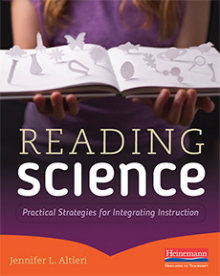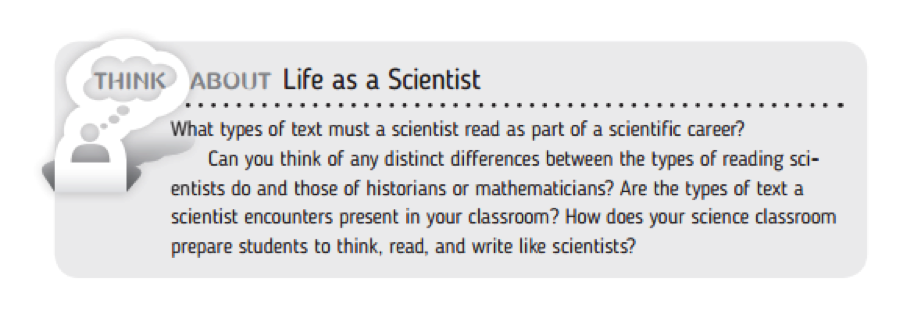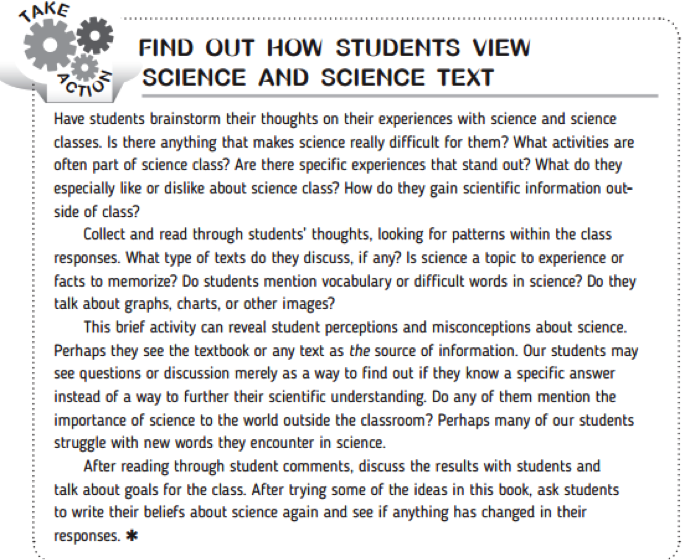Strategies to Integrate Science and Literacy
Reading Science: Practical Strategies for Integrating Instruction
By Jennifer L. Altieri
(Heinemann, 2016 – Learn more)

It wasn’t until I became a teacher that I realized the introduction of a book was the first step in learning about the author, the author’s purpose, and what the author truly believed.
In the “good old days” when I was in school and college we often skirted around the introductions to textbooks and other nonfiction. I didn’t know then what I was missing. The introduction to Jennifer Altieri’s book is a case in point. I came away impressed with her passion for science and literacy.

With the large amount of scientific information we expect our students to learn today, we already struggle to find enough minutes in the classroom to develop that knowledge. Then just when we feel like we don’t have an extra minute to spare, we have the additional pressure to include literacy skills.” (p.xi)
Altieri knows what we are facing as teachers of science. Unless our students understand how to read scientific text, they are going to struggle. They won’t be able to comprehend what they are learning and why they are learning it.
Her goal in Reading Science is to help us reduce that struggle.
What’s inside the book
Each of the five chapters is engaging and informing. The book includes sections that ask you to “Think About It” and “Take Action,” encouraging you to reflect on your own teaching and try new ideas. It is a book for risk takers and education movers and shakers.
Standards’ impact on science reading
Before I started to read the book, I thought about my own students. They devour books about scientific concepts, but many of them struggle to comprehend the text, especially reading scientific articles. They are able to read the words but not always able to synthesize what they read.

I knew that I needed to have undivided attention as I read this book, so I read it at a local coffee house in Princeton, New Jersey, sipping iced coffee and annotating in the margins. I guess I must have had that aurora of joy on my face . One of the patrons leaned over and asked me “what in the world are you reading?” I guess she didn’t expect to find out that it was a book about “reading science.”
Reading with your team
“It takes a village” is a quotation that we have heard in the past. It takes a “village” to teach our students, for sure. Teaching science shouldn’t be a solitary activity – it’s most effective when we work in teams. While this book is written to be read individually, when we read it as a disciplinary team with science literacy in mind, our students will benefit.
When we team up to meet the nonfiction literacy challenge, we’ll enable our students to rise to the top and be deep and challenging thinkers. We also need to address the sobering statistic that “in some classes elementary science is no more than 16 minutes a day – less time than for announcements, walking to the bus, or even standing in line for lunch!” (Winters, Keegan, 2006) That statistic may have improved in some schools since the advent of the Common Core. Has it improved in yours?
Each of Altieri’s chapters is written with immediate application in mind, and each chapter builds upon the ones before. With easy-to-follow ideas and insightful calls to action, this book will give you all of the steps you need to “embrace the challenges and opportunities of science and literacy” (p.5) whenever you are ready.
 Research combined with teacher experience
Research combined with teacher experience
Grounded in research, teacher experience, and purposeful techniques, this book will help you continue your path to scientific literacy, guiding your students to become the scientists they aspire to be. I particularly love the adaption of the 3-2-1 Strategy (Zygouris-Coe, Wiggins, and Smith, 2004).
After completing an experiment or hands-on activity, ask the students to write 3 interesting facts, 2 ways they can connect the information BACK to the scientific text they are reading, and 1 question they still have about the topic.
I love it! It guides the students to understand that the information they are reading and the work they are doing actually connect information about science with the work of science. It’s important for them to understand that after they finish reading about science, the research, analysis, and experimenting don’t just stop. The questions they ask will motivate them to continue to read additional scientific text.
For educators beyond science
Reading Science: Practical Strategies for Integrating Instruction is a must for teachers in elementary and middle school. Although the author centers her scenarios and examples around the subject area of science, the strategies included can be adapted very easily to social studies, math, or any other curricular area where close reading of nonfiction text plays a key role in learning. The activities are easy to use and modify. They invite collaboration among students as they learn to “read like scientists.”
I recommend reading this book with a pencil and sticky notes in hand; a computer with Internet access to look for scientific text; chart paper; and a cup of coffee or tea! Whether you read it in your local coffee shop, with a colleague or alone, don’t skip any sections. Everything fits together like a puzzle.
No matter how you read it or where you read it, Altieri will convince you that YOU can integrate literacy into your science classroom and make you excited about trying the strategies.
________
Linda Biondi is a fourth grade teacher at Sharon Elementary School in Robbinsville, NJ, and a long-time Morning Meeting practitioner. She’s also the recipient of several educational grants, a Teacher Consultant with the National Writing Project, and a participant on the NJ Department of Education Teacher Advisory Panel. Linda participates in ECET2 Celebrate Teaching which has posted an interview with her.































